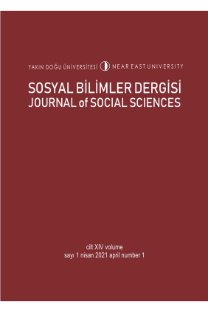OECD ÜLKELERİNDE KISA VADELİ SERMAYE AKIMLARI VE EKONOMİK BÜYÜMENİN CARİ AÇIK ÜZERİNDEKİ ETKİSİNİN STATİK VE DİNAMİK PANEL VERİ MODELLERİYLE TAHMİNİ
Bu çalışmada 19 OECD ülkesinde 1995-2010 dönemi için diğer değişkenlerin sabit olduğu varsayımı altında cari açık üzerinde kısa vadeli sermaye akımları ve ekonomik büyümenin etkili olup olmadığını alternatif tahmin yöntemlerinden hangisinin daha iyi tahmin ettiği araştırılmıştır. Bu bağlamda statik panel veri modellerinden sabit etkiler ve tesadüfî etkiler yöntemi kullanılmıştır. Dinamik panel veri modellerinden ise Arellano-Bond tarafından geliştirilen Genelleştirilmiş Moment yöntemi ve Blundell-Bond tarafından geliştirilen Sistem Genelleştirilmiş Moment yöntemi kullanılmıştır. Uygulanan bu yöntemler sonucunda çalışma konusunu oluşturan modeli statik panel veri için sabit etkiler yönteminin, dinamik panel veri için ise Sistem Genelleştirilmiş Moment yönteminin daha etkin ve tutarlı olduğu sonucuna ulaşılmıştır. Ayrıca, sabit etkiler yöntemi ve Blundell-Bond yöntemine göre ise kısa vadeli sermaye akımlarının cari açığı negatif etkilediği sonucuna varılmıştır.
ESTIMATING THE EFFECT OF SHORT TERM CAPITAL FLOWS AND ECONOMIC GROWTH OVER THE CURRENT DEFICIT IN OECD COUNTRIES BY USING STATIC AND DYNAMIC PANEL DATA MODELS
This study aims to investigate, which of the estimating methods is better, among the alternative estimating methods, in determining whether or not the short term capital flows and economic growth is decisive on the current account deficit, - under the assumption that other variables are constant - in 19 OECD countries for the period of 1995-2010. In this context, the fixed effects and random effects methods of static panel data models are used. Also from among dynamic panel data models, Generalized Moment method improved by Arellano-Bond and System Generalized Moment method improved by Blundell-Bond are employed. As the final result of using these methods, it is found that the fixed effects method for static panel data and System Generalized Moment method for dynamic panel data are more effective and consistent for the estimation of the model implemented in this research. In addition, according to the fixed effect method and Blundell-Bond method, it is concluded that short term capital flows has a negative impact on the current account deficit.
___
- Arellano, M., Bond S. R. (1991). “Some Tests of Specification for Panel Data: Monte Carlo Evidence and An Application to Employment Equations”, The Review of Economic Studies, Vol. 58, No. 2, pp. 248.
- Aristovnik, A., (2006). “The Determinants & Excessiveness of Current Account Deficits in Eastern Europe & The Former Soviet Union”, Transformations, Business & Economics , Vol. 6, No. 11, (2007): pp. 32-52.
- Blundell, R., Bond S., F., Windmeijer, (2000). “Estimation in Dynamic Panel Data Models: Improving on the Performance of the Standard GMM Estimators”, The Institute For Fiscal Studies Working.
- Bagnai A., S., A. Manzocchi (1998). “Current Account Reversals in Developing Countries: The Role of Fundamentals”, Open Economic Review, No. 10, (1998), pp. 143-163.
- Baltagi, B. H. (2001). “Econometric Analysis of Panel Data”, Second Edition, John Wiley and Sons, Chichester, United Kingdom.
- Bussiere, M., Fratzscher, M., ve Muller, G. J. (2004). “Current Account Dynamics in OECD and EU Acceding Countries: An Intertemporal Approach”, European Central Bank Working Paper, No. 311.
- Calderon, A., Chong, C., Loayzo A. ve Norman, V. (1999). “Determinants of Current Account Deficits in Developing Countries”, Contributions to Macroeconomics, Vol. 2.
- Chinn, M., Prasad, E.S. (2000). “Medium Term Determinants of Current Accounts in Industrial and Developing Countries: An Empirical Exploration”, NBER Working Paper, No. 7581.
- Debelle G., H. Faruqee (1996). “What Determines The Current Account?” IMF Working Paper, No. 58.
- Dinardo, J.J. (1996). “Econometric Methods”, McGraw Hill International Editions Economic Series, Fourth Edition.
- Dornbusch, R. (2001). “A Primer On Emerging Market Prices” Paper Presented At The NBER Conference On Preventing Currency Crises in Emerging Markets, January, 11-13.
- Freund, C. L. (2000). “Current Account Adjustment in Industrialized Countries”, Board of Govemers of the FED. International Finance Discussion Papers.
- Fischer, S., (1993), “The Role of Macroeconomic Factors in Growth” Journal of Monetary Economics 32 (3), pp. 485-511.
- Freund, C., Warnock, F. (2005). “Current Account Deficits in Industrial Countries: The Bigger They are, The Harder They Fall?”, NBER Working Paper, No. 11823, pp. 1-23.
- Hepaktan, E., S. Çınar (2012). “OECD Ülkelerinde Büyüme-Cari İşlemler Dengesi İlişkisi: Panel Veri Analizi” Anadolu Üniversitesi Sosyal Bilimler Dergisi”, Sayı: 2, pp. 43-57.
- Im, K., S., Pesaran, M.,H., SHİN Y. (2003). “Testing For Unit Roots in Heterogeneous Panels” Journal of Econometrics, Vol. 115, No. 1.
- Kandil, M., J. Greene, (2002), “The Impact of Cyclical Factors on the U.S. Balance of Payments”, IMF Working Paper, No. 45.
- Levin A., Lin C. F., C. Chu (2002), “Unit Root Tests in Panel Data: Asymptotic and Finite-Sample Properties,” Journal of Econometrics, 108, 1-24.
- Malik, S., I. S. Chaudhry, M. R Sheikh, F. S. Farooqi (2010). “Tourism, Economic Growth and Current Account Deficit in Pakistan: Evidence from Co-integration and Causal Analysis” European Journal of Economics, Finance and Administrative Sciences.
- Milesi-Ferretti, G.M. and A. Razin (1996). “Current Account Sustainability”, Princeton Studies in International Finance, No. 81.
- Prasad, E. S., R. G. Rajan and A. Subramanian (2007). “Foreign Capital and Economic Growth”; Brookings Papers on Economic Activity, Vol. (1), pp. 153-209.
- ISSN: 1986-1303
- Yayın Aralığı: Yılda 2 Sayı
- Başlangıç: 2008
- Yayıncı: Yakın Doğu Üniversitesi
Sayıdaki Diğer Makaleler
BİR ÇALIŞMA ALANI OLARAK KARİYERİN SOSYOLOJİ VE PSİKOLOJİ DİSİPLİNLERİNDEKİ TEMELLERİ
TÜRKİYE’DE SÜRDÜRÜLEBİLİR CARİ AÇIK
TÜRKİYE VE BİLGİ TOPLUMU SİYASASI: BİR TOPLUMSAL DÖNÜŞÜM HİKÂYESİNİ YENİDEN OKUMAK
TOCQUEVİLLE’İN DEMOKRASİ TEORİSİNE KATKILARI ÜZERİNE
CEREN KALFA ATAAY, FARUK ATAAY
AVUSTRALYA’DA TUTUKLU MÜLTECİLERİN DURUMU: 1996-2001
2000’Lİ YILLARDA GRAMSCİ’Yİ ANLAMAK: ORTAK DUYUNUN KAYNAĞI OLARAK TOPLUMSAL HAREKETLERİN ÖNEMİ
SOCIAL AND ENVIRONMENTAL AWERENESS OF FOREIGN STUDENTS IN NORTH CYPRUS
